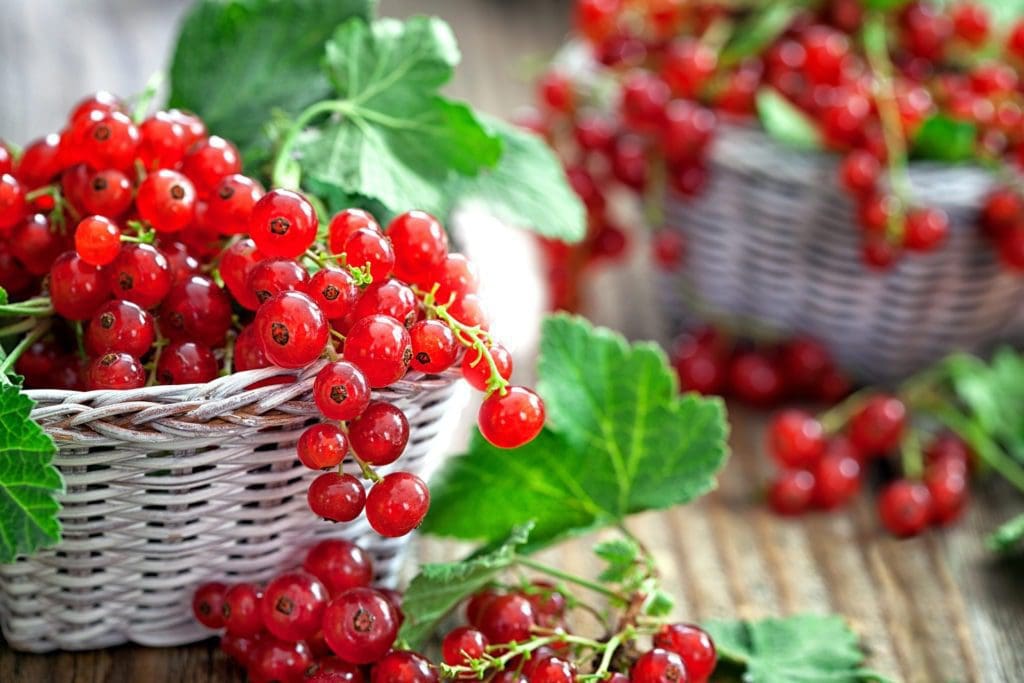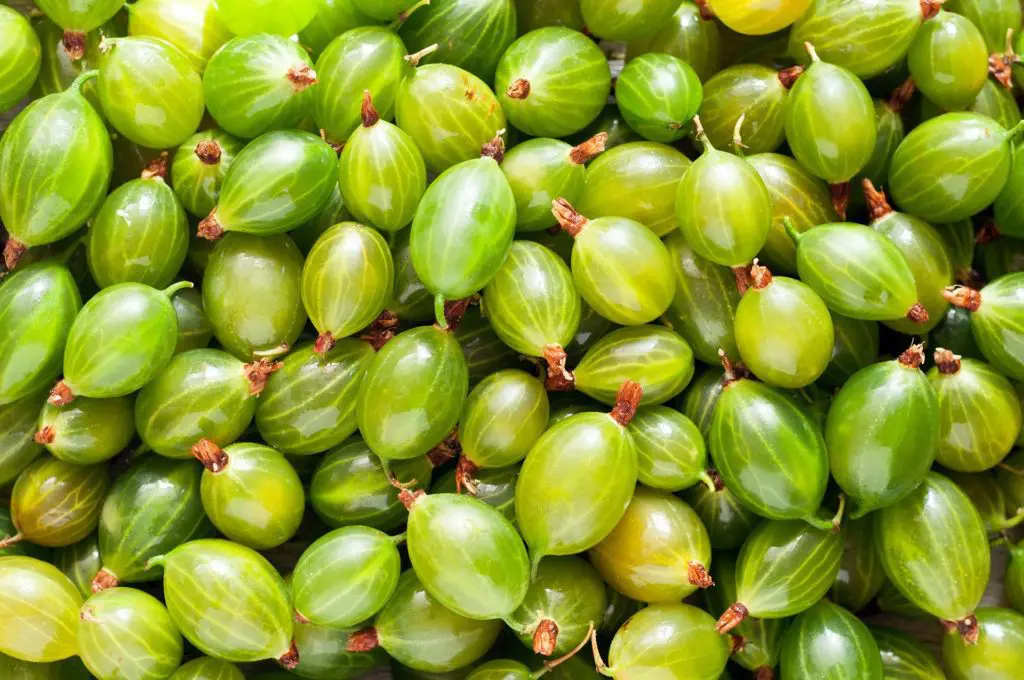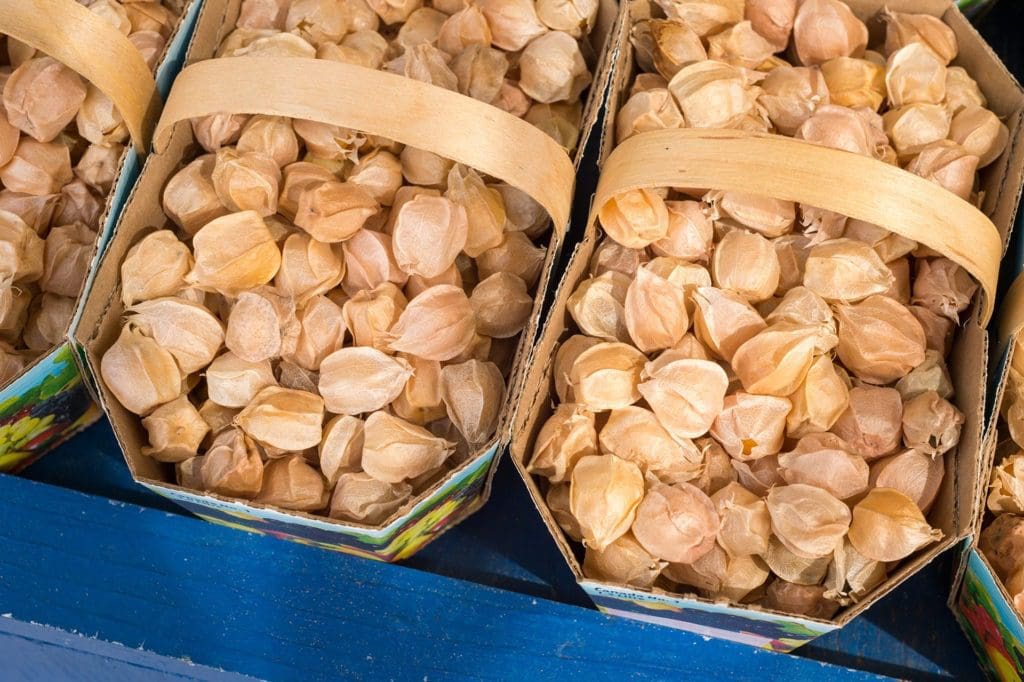9 Surprising Fruits and Vegetables at The Farmers’ Market
Ah, summer. The season when the farmers’ market is bursting at the seams with corn, tomatoes, peaches, berries and more. And while we’re fans of those classics, and the season’s bumper crop of zucchini, there are some oft-forgotten items we also love to seek out this time of year. From the tropical flavors of ground cherries and the bright pop of currants to the crisp bite of purslane, here are nine ingredients you may not recognize at your neighborhood market stall. Now you will, and we highly suggest you try them out!
Find other in-season produce near you with our Seasonal Food Guide.

Currants
Although they resemble winter’s mistletoe buds, currants are in fact a tart, just-sweet-enough summer berry. You’ll find them in black, red, white and pink varieties, most likely at the farmers’ market, from July to August, depending on where you live. Delicious eaten out of hand, currants can also be used to make preserves, substituted in for dried fruits in baked goods, tossed into salads and turned into sauce to accompany roasted meats. Choose shiny and plump currants that are still attached to their stem.
Get more information about cooking and shopping for currants in the Real Food Encyclopedia.
Bitter Melon
This summer fruit is not lying about its name — its bite is so bitter, those unfamiliar might reject it at first taste. But the fruit (cousin to cucumbers and melons) is grown extensively in India, Southern China and other parts of Southeast Asia for good reason — bitter melon is packed with nutrients and its sharp flavor is the perfect addition spicy and rich foods like curry, stir-fry (often prepared with Chinese black beans), and stews. In the US, you’ll most likely find it at summer markets from farmers specializing in Asian produce (or Asian specialty grocers); when you do, look for the green ones if you prefer bitter flavor or orange-to-yellow ones for aif you prefer things milder.
Get more information about cooking and shopping for bitter melon in the Real Food Encyclopedia.
Apriums/Pluots/Plumcots
While you’re probably familiar with plums and you may love apricots, there are several cross-bred varieties of these jewels you might not know. This summer keep an eye out for apriums, pluots, plumcots and apriplums — all plum-apricot hybrids. By mixing the two varieties, you get results that range wildly in size, color (like the deep green skin of Emerald Drops or the golden yellows of Tropical Sunrise), sweetness (Flavorosas are super sweet!) and flavor undertones (try Flavor Grenade for a tropical, pineapple flavor). Use them the same way you enjoy plums or apricots: toss them into fruit salad, bake them into pie, cook them into preserves or puree them and mix into cockails. That is, if you don’t bite into them immediately after nabbing them at the market.

Gooseberries
Similar in spherical shape and translucent appearance to currants, gooseberries are much more common in Europe, especially England, than the US. Gooseberries have quite a tart bite — most recipes suggest cooking them with sugar, like rhubarb, to soften the flavor. They are also often paired with sweet, fragrant elderflower. The traditional dish for this classic English berry is the fool, a simple dessert made with sweetened gooseberries and whipped cream. Try using them similarly to currants, for jam, sauce and as a cocktail mix-in. You’ll find them from June to August, depending on variety and location, at the farmers’ market or a produce specialty store.
Get more information about cooking and shopping for gooseberries in the Real Food Encyclopedia.
Kohlrabi
You may have seen kohlrabi at the farmers’ market and said, “What is that alien-looking thing?” Kohlrabi’s certainly got a unique look, with its knobby bulb, long stretched-out stems and big, flat leaves. The blub has a tough outer skin that must be trimmed away, but once you’ve mastered that, the veggie — which tastes similar to broccoli-stems — is wonderful added into coleslaws, mashed with potatoes or roasted as a side dish. Use the leaves like kale, raw, cooked, roasted, etc. Available in purple or green, the plant starts appearing in late May and goes through the end of November, depending on your location. In warmer climates it may also be available in winter. Look for firm, smaller bulbs (they’ll be more tender) with no brown spots and crisp leaves.
Get more information about cooking and shopping for kohlrabi in the Real Food Encyclopedia.
Prickly Pears and Nopales
Prickly pears are so important in Mexican cuisine that the fruit appears on the Mexican flag. This national cactus pride is not surprising — cactus paddles, nopales, and their fruit, prickly pears, are nutrient- and fiber-rich and have been used to treat everything from arthritis pain to hangovers. You’re more likely to spot these at the farmers’ market in southwestern states starting mid-summer; in other areas look for them at specialty grocers. Choose bright green paddles that are soft, but not floppy, and fruit that is firm and blemish free. Because both the pears and cactus have prickly cacti spikes, be careful when cleaning them. Once you’ve done the prep, try the paddles — which have a similar flavor to green peppers — in nopales tacos, roasted with meats or fried with tofu, or breaded and fried into cactus fries. Prickly pears make an excellent dipping sauce for those fries, can be turned into a delicious jelly, and are a favorite flavor addition to margaritas.

Ground Cherries
With a tempting flavor profile of pineapple, strawberry and green grapes, it’s surprising that ground cherries aren’t more popular. Also called cape gooseberries, the tropical-tasting, yellow-orange fruits are enrobed in a papery husk. You’ll find them starting around July; look for gooseberries with husks that are papery and straw-to-tan colored (similar to a tomatillo husk). Remove the husks, then snack on them raw, or use them for desserts, salads or dip them in chocolate for a cute party treat. Ground cherries have a short but sweet season — from late summer through the beginnings of fall — so catch them when you can.
Get more information about cooking and shopping for ground cherries in the Real Food Encyclopedia.
Lamb’s Quarters
Despite the fact that it’s a common garden weed, this spinach-like green is highly popular in Indian, Korean and Chinese cuisine, and making headway on the American palate. Look for bright, plump leaves when shopping for lamb’s quarters at the farmers’ market — the only place you’re likely to find it, as this is a foraged, not cultivated item — in season from early summer through the fall’s first frost. Swap it in for any spinach recipe, or try using lamb’s quarters in kimchi, pesto, creamy soup or even your morning smoothie.
Get more information about cooking and shopping for lamb’s quarters in the Real Food Encyclopedia.
Purslane
Snacking on purslane is one of those good-for-you, good-for-environment things, since it’s a common weed that you can eat instead of toss out, and which also happens to be delicious and nutritious. But be careful where you get it! Cultivated and wild-foraged purslane is a wonderful addition to your salad bowl, but because it is considered invasive in many places (such as industrial agricultural settings), the plant is often sprayed with noxious herbicides. You’ll start seeing purslane at the farmers’ market in early June through the end of fall; look for stems and leaves that are firm and fleshy to the touch. Tart and succulent, purslane is a great mix-in for salads, but it can also be sautéed, stewed and pickled.
Get more information about cooking and shopping for purslane in the Real Food Encyclopedia.
Get the latest food news, from FoodPrint.
More Reading
Can rye growers get consumers and retailers excited about rye?
May 19, 2025
How one New Jersey farm grows food year round
April 3, 2025
Returning seeds to their ancestors: Revitalizing biodiversity and foodways through plant rematriation
March 24, 2025
Fermenting and freezing are your secret weapons for preserving root vegetables
October 17, 2024
Quinces are due for a renaissance
September 16, 2024
Six unusual greens to try
September 4, 2024
These 5 new cookbooks will help you master late-summer eating
July 29, 2024
Celebrate seasonal eating with our 5-night late-summer meal plan
July 22, 2024
Some foods are styled as ‘climate saviors.’ Who are they saving?
May 21, 2024
Protecting endangered foods one bite at a time
May 6, 2024
